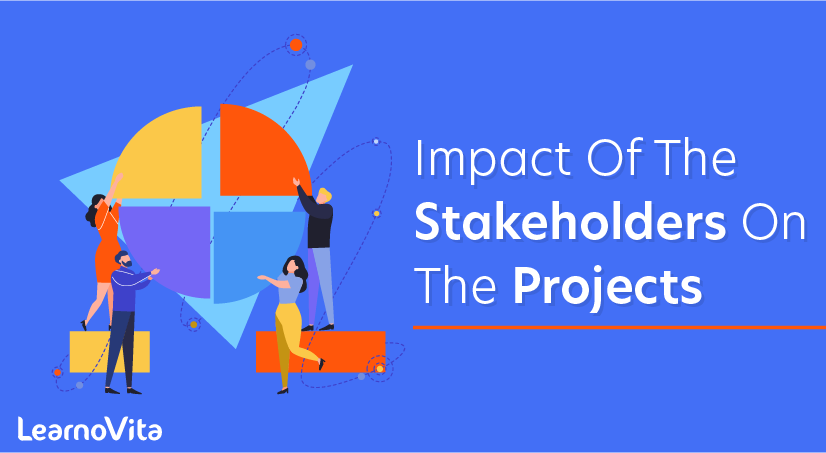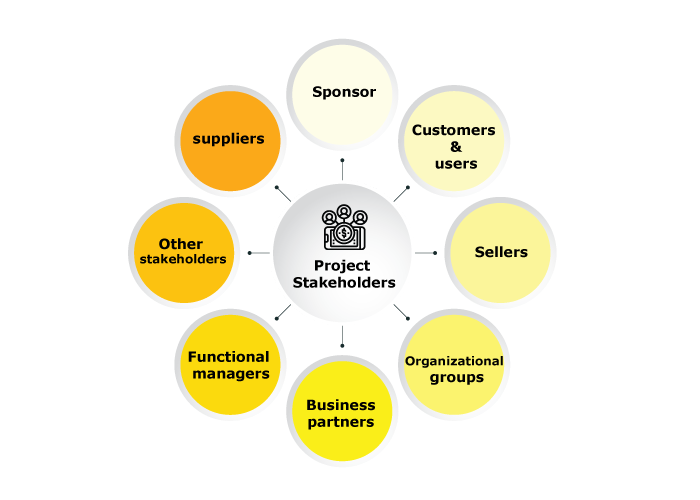
Impact of the stakeholders on the projects
Last updated on 10th Oct 2020, Artciles, Blog
Who are the Stakeholders?
- A stakeholder is an individual, group, or organization who may affect, be affected by, or perceive itself to be affected by a decision, activity, or outcome of a project. Stakeholders are either directly involved in the project or have interests that may be affected by the project’s outcome. It includes normally the members of a project team: project managers, project sponsors, executives, customers, or users.
- It’s beneficial and advisable to know about good stakeholder management skills and communicate constantly with stakeholders in order to collaborate on the project coz after all, they are also affected by the product.
- If a project is small in size, the number of stakeholders can be small. However, if it is large and expanded to a large area, one may have a huge number of stakeholders, including communities or the general public. Also, all stakeholders are not alike. They have different expectations and needs. One must treat every stakeholder uniquely according to their needs or else the stakeholders might feel left out which can put the project in danger.
- Different stakeholders often have opposing expectations that might create clashes within the project. Stakeholders may also interfere in the project, its deliverables, and the project team to fulfill their strategic business objectives or other requirements.
Subscribe For Free Demo
Error: Contact form not found.
Type of Project Stakeholders
Project stakeholders can be classified into two types:
Internal Stakeholders:
As the name suggests, these are the people involved in a project from within. They include:
- A sponsor
- An internal customer or client (if the project started due to an internal need of the organization)
- A project team
- A program or portfolio manager
- Management
- Another team’s manager of the company
External Stakeholders:
These stakeholders are not directly involved but are engaged from outside and are affected by the project outcome.
- An external customer or client (if project started due to a contract from external party)
- An end user
- Subcontractors
- A supplier
- The government
- Local communities
- Media
Identify stakeholders
Ideally, a project manager should identify the stakeholders at the initial stages as it will cost hugely if you missed out any key stakeholders during that period. As per PMI®, it is an initiation process in the communication knowledge area.
Impact of the stakeholders on the projects:
It can be very costly if you ignore any of the stakeholder’s expectations and it can hugely impact the project negatively like delay in deliveries. Suppose you need the resources for running the project as planned and if you have managed the expectations of HR manager positively then you will surely get a soft support from your HR manager because you’ve managed his/her expectations at the initial stage and the result can be vice-versa in case you have not managed his/her expectations initially.
Furthermore, a project manager must manage the influence of all the stakeholders in relation to the project requirements to ensure a required output. The project manager should take care of the interests of the stakeholders balancing the requirements of the project.
Why are stakeholders important for a project?
- Stakeholders have different levels of duties and authority when contributing on a project. This level may differ as the project proceeds. It can range from occasional contributions to full project sponsorship.
- Some stakeholders may also detract from the success of the project, either actively or passively. These stakeholders need the project manager’s attention during the whole time of the project’s life cycle.
- Stakeholder identification is a continuous process during the entire project life cycle. Identifying them, understanding their level of effect on a project, and satisfying their demands, needs, and expectations is essential for the success of the project.
- Just as stakeholders can affect a project’s objectives positively or negatively, a project can be perceived by the stakeholders as having positive or negative results.
- One of the most important responsibilities of a project manager is to manage stakeholder expectations, which can be problematic as stakeholders often have very diverse or conflicting objectives.
Project Stakeholders

- Sponsor: A sponsor is the person or group who provides supplies and support for the project and is liable for assisting success. He may be external or internal to the organization.
- Customers and users: Customers are the people or organizations who will approve and manage the project’s product, service, or result. Users, as clear from the name, use the product.
- Sellers: Sellers, also known as vendors, are external companies that enter into a contractual agreement to provide services or resources necessary for the project.
- Business partners: They are external organizations that have a special relationship or partnership with the enterprise.
- Organizational groups: Organizational groups are internal stakeholders who are influenced by the actions of the project team. For example, human resources, marketing, sales, legal, finance, operations, manufacturing, etc.
- Functional managers: They are key individuals who play the role of management within an administrative or functional area of the business. For example, human resources, finance, accounting, etc.
- Other stakeholders: They are additional stakeholders which include financial institutions, government regulators, subject matter experts, consultants, and others, which have a financial interest in the project, contributing inputs to the project, or have in the outcome of the project.
Stakeholders are people who get affected by your project or have any kind of interest in it. They can be internal, external, positive, negative, high power, low power, etc. However, to complete your project successfully you have to manage all these stakeholders and fulfill their prospects.
Are you looking training with Right Jobs?
Contact UsRelated Articles
Popular Courses
- PMP Certification Training
13726 Learners - CAPM Certification Training
14635 Learners - Jira Training
12876 Learners
- What is Dimension Reduction? | Know the techniques
- Difference between Data Lake vs Data Warehouse: A Complete Guide For Beginners with Best Practices
- What is Dimension Reduction? | Know the techniques
- What does the Yield keyword do and How to use Yield in python ? [ OverView ]
- Agile Sprint Planning | Everything You Need to Know
